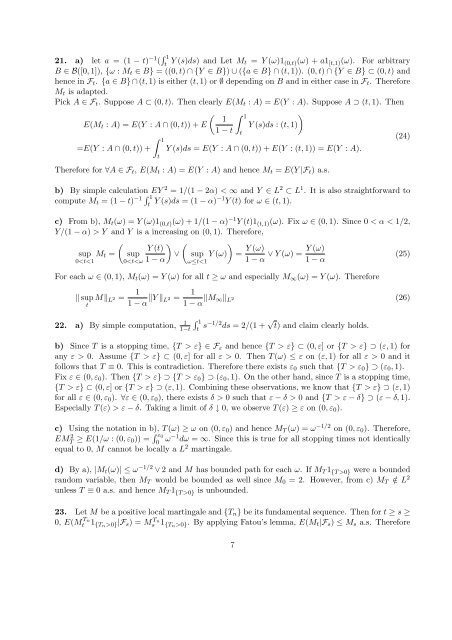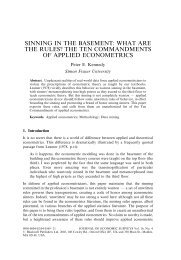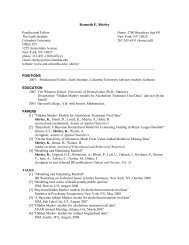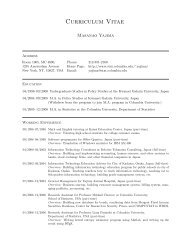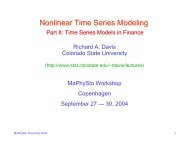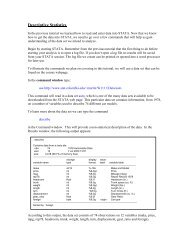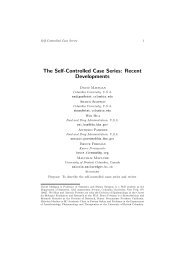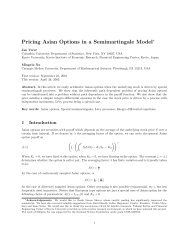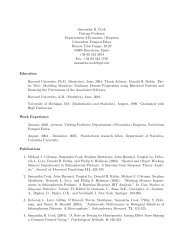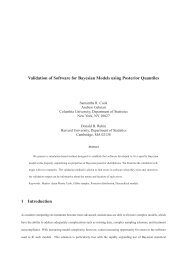Solution to selected problems.
Solution to selected problems.
Solution to selected problems.
You also want an ePaper? Increase the reach of your titles
YUMPU automatically turns print PDFs into web optimized ePapers that Google loves.
21. a) let a = (1 − t) −1 ( ∫ 1<br />
t Y (s)ds) and Let M t = Y (ω)1 (0,t) (ω) + a1 [t,1) (ω). For arbitrary<br />
B ∈ B([0, 1]), {ω : M t ∈ B} = ((0, t) ∩ {Y ∈ B}) ∪ ({a ∈ B} ∩ (t, 1)). (0, t) ∩ {Y ∈ B} ⊂ (0, t) and<br />
hence in F t . {a ∈ B} ∩ (t, 1) is either (t, 1) or ∅ depending on B and in either case in F t . Therefore<br />
M t is adapted.<br />
Pick A ∈ F t . Suppose A ⊂ (0, t). Then clearly E(M t : A) = E(Y : A). Suppose A ⊃ (t, 1). Then<br />
( ∫ 1 1<br />
)<br />
E(M t : A) = E(Y : A ∩ (0, t)) + E<br />
Y (s)ds : (t, 1)<br />
1 − t t<br />
(24)<br />
=E(Y : A ∩ (0, t)) +<br />
∫ 1<br />
t<br />
Y (s)ds = E(Y : A ∩ (0, t)) + E(Y : (t, 1)) = E(Y : A).<br />
Therefore for ∀A ∈ F t , E(M t : A) = E(Y : A) and hence M t = E(Y |F t ) a.s.<br />
b) By simple calculation EY 2 = 1/(1 − 2α) < ∞ and Y ∈ L 2 ⊂ L 1 . It is also straightforward <strong>to</strong><br />
compute M t = (1 − t) −1 ∫ 1<br />
t Y (s)ds = (1 − α)−1 Y (t) for ω ∈ (t, 1).<br />
c) From b), M t (ω) = Y (ω)1 (0,t) (ω) + 1/(1 − α) −1 Y (t)1 (t,1) (ω). Fix ω ∈ (0, 1). Since 0 < α < 1/2,<br />
Y/(1 − α) > Y and Y is a increasing on (0, 1). Therefore,<br />
(<br />
) ( )<br />
Y (t)<br />
sup M t = sup ∨ sup Y (ω) = Y (ω)<br />
Y (ω)<br />
∨ Y (ω) = (25)<br />
0 ε} ⊂ (0, ε] for all ε > 0. Then T (ω) ≤ ε on (ε, 1) for all ε > 0 and it<br />
follows that T ≡ 0. This is contradiction. Therefore there exists ε 0 such that {T > ε 0 } ⊃ (ε 0 , 1).<br />
Fix ε ∈ (0, ε 0 ). Then {T > ε} ⊃ {T > ε 0 } ⊃ (ε 0 , 1). On the other hand, since T is a s<strong>to</strong>pping time,<br />
{T > ε} ⊂ (0, ε] or {T > ε} ⊃ (ε, 1). Combining these observations, we know that {T > ε} ⊃ (ε, 1)<br />
for all ε ∈ (0, ε 0 ). ∀ε ∈ (0, ε 0 ), there exists δ > 0 such that ε − δ > 0 and {T > ε − δ} ⊃ (ε − δ, 1).<br />
Especially T (ε) > ε − δ. Taking a limit of δ ↓ 0, we observe T (ε) ≥ ε on (0, ε 0 ).<br />
c) Using the notation in b), T (ω) ≥ ω on (0, ε 0 ) and hence M T (ω) = ω −1/2 on (0, ε 0 ). Therefore,<br />
EMT 2 ≥ E(1/ω : (0, ε 0)) = ∫ ε 0<br />
0 ω−1 dω = ∞. Since this is true for all s<strong>to</strong>pping times not identically<br />
equal <strong>to</strong> 0, M cannot be locally a L 2 martingale.<br />
d) By a), |M t (ω)| ≤ ω −1/2 ∨ 2 and M has bounded path for each ω. If M T 1 {T >0} were a bounded<br />
random variable, then M T would be bounded as well since M 0 = 2. However, from c) M T /∈ L 2<br />
unless T ≡ 0 a.s. and hence M T 1 {T >0} is unbounded.<br />
23. Let M be a positive local martingale and {T n } be its fundamental sequence. Then for t ≥ s ≥<br />
0, E(Mt<br />
Tn 1 {Tn >0}|F s ) = M T n<br />
s 1 {Tn >0}. By applying Fa<strong>to</strong>u’s lemma, E(M t |F s ) ≤ M s a.s. Therefore<br />
7


